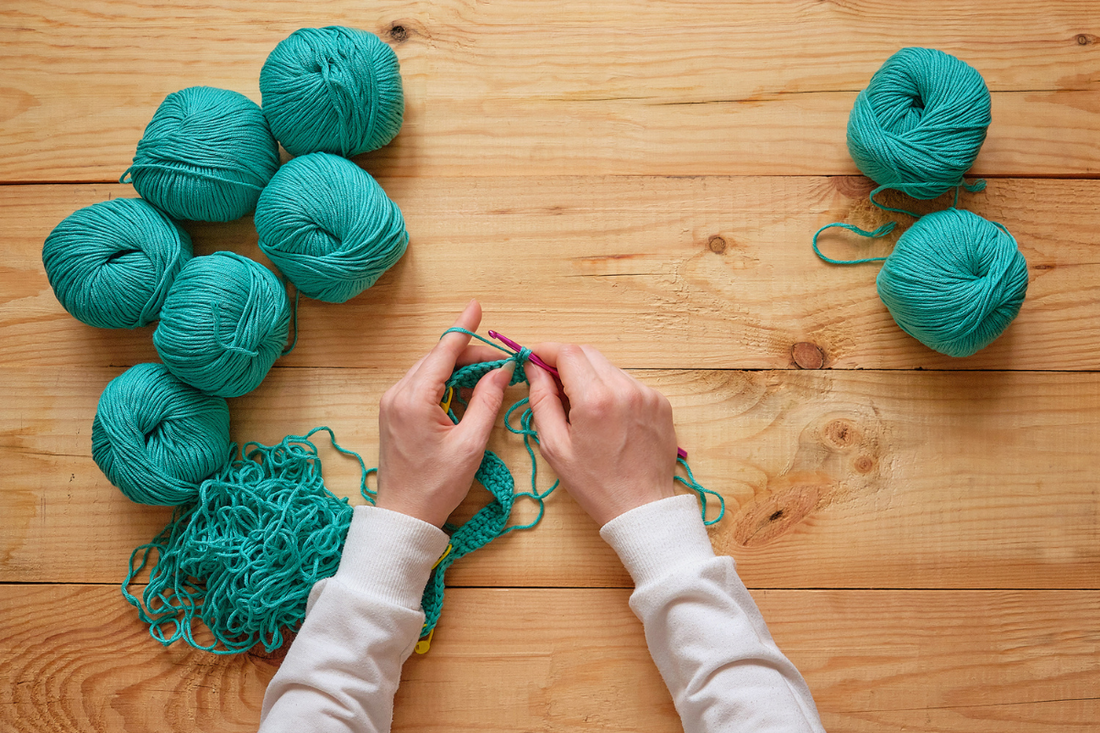Crocheting is an exciting hobby growing in popularity every day, that allows people to create a wide variety of beautiful and intricate designs. In order to create these designs, crocheters use a variety of different stitches, each of which has its own unique characteristics and uses. In this article, we will explain seven of the most common crochet stitches: dc2tog, sc2tog, magic knot, hdc, reverse single crochet (crab stitch), puff stitch, and granny stitch (granny square stitch).
The dc2tog
The dc2tog (double crochet 2 together) is a decrease stitch that is used to decrease the width of a piece of crocheted fabric. To make this stitch, you will need to yarn over the hook, insert the hook into the next stitch, and draw up a loop. Then, yarn over and draw through two loops on the hook. Repeat this process in the next stitch, and then yarn over and draw through all three loops on the hook to complete the dc2tog.
The sc2tog
The sc2tog (single crochet 2 together) is another decrease stitch that is similar to the dc2tog. To make this stitch, you will need to insert the hook into the next stitch, yarn over and draw up a loop, yarn over and draw through two loops on the hook. Then, repeat this process in the next stitch, and yarn over and draw through all three loops on the hook to complete the sc2tog.
The Magic Knot
The magic knot is a technique that is used to join two ends of yarn together without leaving a visible knot. To make this knot, you will need to tie a regular knot with the two ends of yarn, but leave a small loop at the end. Then, insert the hook through the loop, grab the two ends of yarn, and pull them through the loop. Tighten the knot by pulling on the two ends of yarn, and then trim the excess yarn.
The hdc
The hdc (half double crochet) is a stitch that is used to create a fabric with a slightly taller and looser texture than the single crochet stitch. To make this stitch, you will need to yarn over the hook, insert the hook into the next stitch, and draw up a loop. Then, yarn over and draw through all three loops on the hook to complete the hdc.
The reverse single crochet
The reverse single crochet, also known as the crab stitch, is a decorative stitch that is used to create a ridged edge on a piece of crocheted fabric. To make this stitch, you will need to work in the opposite direction that you normally would, inserting the hook into the previous stitch instead of the next stitch. Yarn over and draw up a loop, yarn over and draw through two loops on the hook to complete the reverse single crochet.
The puff stitch
The puff stitch is a decorative stitch that is used to create a raised and textured effect on a piece of crocheted fabric. To make this stitch, you will need to yarn over the hook, insert the hook into the next stitch, and draw up a loop. Then, without completing the stitch, repeat this process in the same stitch again. You should now have three loops on the hook. Yarn over and draw through all three loops on the hook to complete the puff stitch.
The Granny Stitch (Granny Square Stitch)
The Granny Stitch it arguably the most complicated of these stitches. But really, once you know the chain, double crochet and slip stitches, it is so simple!
Begin by making a chain stitch that is a multiple of three stitches plus one (e.g., 4, 7, 10, etc.).
Skip the first two stitches and double crochet in the third stitch from the hook.
Skip the next two stitches, double crochet in the next stitch, and then double crochet in each of the two skipped stitches. Repeat from * to * until you reach the end of the row.
At the end of the row, slip stitch into the top of the first double crochet of the previous row.
Chain three and double crochet in each stitch across the row, making three double crochets in each corner stitch.
Repeat steps 4 and 5 until your granny stitch is the desired size.
To finish off your granny stitch, simply cut the yarn and pull the end through the last loop on your hook to secure it.
These seven crochet stitches are some of the most common and versatile techniques used by crocheters. Each of these stitches has its own unique characteristics and uses, and by mastering them, you can create a wide range of beautiful and intricate designs.
